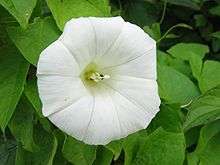Calystegia
Calystegia (bindweed, false bindweed, or morning glory) is a genus of about 25 species of flowering plants in the bindweed family Convolvulaceae. The genus has a cosmopolitan distribution in temperate and subtropical regions, but with half of the species endemic to California. They are annual or herbaceous perennial twining vines growing 1–5 m tall, with spirally arranged leaves. The flowers are trumpet-shaped, 3–10 cm diameter, white or pink, with (in most species) a sometimes inflated basal epicalyx.
| Calystegia | |
|---|---|
 | |
| Calystegia sepium | |
 | |
| Calystegia soldanella | |
| Scientific classification | |
| Kingdom: | Plantae |
| Clade: | Tracheophytes |
| Clade: | Angiosperms |
| Clade: | Eudicots |
| Clade: | Asterids |
| Order: | Solanales |
| Family: | Convolvulaceae |
| Tribe: | Convolvuleae |
| Genus: | Calystegia R.Br.[1][2] |
| Species | |
|
See text | |
The genus bears much similarity to a related genus Convolvulus, and is sometimes combined with it; it is distinguished primarily by the pollen being smooth, and in the ovary being unilocular.
Some of the species, notably Calystegia sepium and C. silvatica, are problematic weeds, which can swamp other more valuable plants by climbing over them, but some are also deliberately grown for their attractive flowers.
Calystegia species are used as food plants by the larvae of some Lepidoptera species including Bedellia somnulentella (recorded on C. sepium) and small angle shades.
The name is derived from two Greek words kalux, "cup", and stege, "a covering", meaning "a covering cup". [3]
Species
The following species are recognised in the genus Calystegia:[4]
- Calystegia affinis
- Calystegia atriplicifolia – nightblooming false bindweed
- Calystegia binghamiae
- Calystegia brummittii
- Calystegia catesbiana – Catesby's false bindweed
- Calystegia collina – Coast Range false bindweed
- Calystegia felix
- Calystegia hederacea – Japanese false bindweed
- Calystegia × howittiorum
- Calystegia × krauseana
- Calystegia longipes – Paiute false bindweed, plateau morning glory
- Calystegia × lucana
- Calystegia macaunii – Macoun's false bindweed
- Calystegia macrostegia – island false bindweed
- Calystegia malacophylla – sierra false bindweed
- Calystegia marginata – small-flowered white bindweed New Zealand[5]
- Calystegia × melnikovae
- Calystegia occidentalis – chaparral false bindweed
- Calystegia peirsonii – Peirson's false bindweed
- Calystegia pellita – hairy false bindweed
- Calystegia pubescens
- Calystegia × pulchra – hairy bindweed
- Calystegia purpurata – Pacific false bindweed
- Calystegia × scania
- Calystegia sepium – large bindweed, hedge bindweed, bearbind, hedgebell (type species)
- Calystegia silvatica – great bindweed, shortstalk bindweed
- Calystegia soldanella – sea bindweed, seashore false bindweed, beach morning glory
- Calystegia spithamaea – low false bindweed, upright bindweed
- Calystegia stebbinsii – Stebbins' false bindweed, Stebbins' morning glory
- Calystegia subacaulis – hillside false bindweed
- Calystegia tuguriorum – New Zealand bindweed, pōuwhiwhi, pōwhiwhi, rarotawake[6]
.jpg) New Zealand bindweed
New Zealand bindweed - Calystegia vanzuukiae

.jpg) Calystegia sepium (van Houtte, L., 1853)
Calystegia sepium (van Houtte, L., 1853)
References
- "Convolvulaceae Calystegia R.Br. The International Plant Name Index (IPNI)". Retrieved 25 April 2018.
- Brown, R. (1810) "Prodromus floræ Novæ Hollandiæ et Insulæ Van-Diemen : exhibens characteres plantarum quas annis 1802-1805: 483". Retrieved 25 April 2018.
- .: Merriam-Webster dictionary:Calystegia]
- "Calystegia R.Br. | Plants of the World Online | Kew Science". Plants of the World Online. Retrieved 2020-04-16.
- "Calystegia marginata | New Zealand Plant Conservation Network". www.nzpcn.org.nz. Retrieved 2018-12-10.
- "Calystegia tuguriorum | New Zealand Plant Conservation Network". www.nzpcn.org.nz. Retrieved 2018-12-10.
External links
